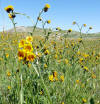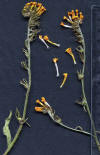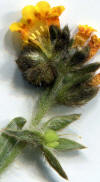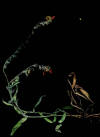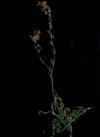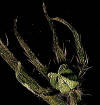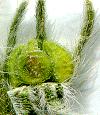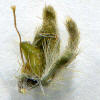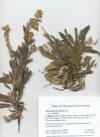 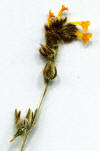 Amsinckia intermedia
Fischer & Meyer |
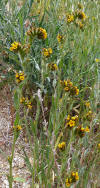   Amsinckia
douglasiana
A. DC. |
Amsinckia
douglasiana
A. DC. |
Amsinckia eastwoodiae
MacBride
|
|
|
Amsinckia eastwoodiae
|
Amsinckia eastwoodiae East facing slopes,
foothill herb-grassland, Kern Co., CA, 19 Feb 2017. Breckenridge
Mt.
|
|||
|
Amsinckia gloriosa
var. indet.
|
||||
|
Amsinckia gloriosa
|
Amsinckia gloriosa
Eastwood ex Suksdorf
|
|||
|
Amsinckia intermedia Fischer & Meyer CA: Kern Co. Kern River Canyon, March 2009, Photo by Susan Spjut. Corolla tube well-exserted from calyx.
|
Amsinckia intermedia
|
Amsinckia intermedia
|
Amsinckia intermedia
|
|
|
Amsinckia intermedia. Two similar specimens collected in the Tejon Hills on Tejon Ranch Conservancy, Kern Co., California, 7 Mar 2015. Corollas ~12 mm long in both, both with 5-lobed calyx; stamens longer than stigma in one species, shorter than stigma in the other, the filaments also appearing lower on the upper part of the corolla tube. Main difference is the mericarps, tuberculate like roof shingles in left (or upper) specimen, tessellate in the other. but also with sawtooth ridges along the dorsal median.
|
||||
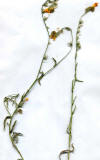    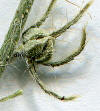  Amsinckia intermedia. Two similar specimens collected along Mill Creek Trail, Kern Co., California, Apr 2010. Corollas ~12 mm long in both, 5-lobed calyx, the lobes slightly broader in one, longer in the other. Main difference is the mericarps, tuberculate in left specimen, A. intermedia var. californica (Suksdorf) Jepson & Hoover, transversely rugose in right specimen, A. intermedia var. intermedia. See Twisselmann, A Flora of Kern County, California in Moe, A Key to Vascular Plant Species of Kern County, California (CNPS, 1995), and illustration in Jepson, A California Flora (1943, Vol. 3, Pt. 2). |
Amsinckia douglasiana
and A. intermedia,
mixed.
|
|||
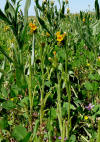 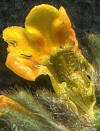
Amsinckia lycopsoides Lehm. |
Amsinckia
sp. |
Amsinckia menziesii
(Lehm.) Nels. & Macbride |
||
|
|
Amsinckia
sp.
|
Amsinckia
sp. Carrizo Plain, March 2010 |
||
|
Amsinckia tessellata
A. Gray
|
Amsinckia tessellata
A. Gray |
Amsinckia desert (A. tessellata) |
Amsinckia tessellata
|
|
|
Amsinckia tessellata
|
Amsinckia vernicosa
Hook. & Arn. var. vernicolsa |
|||
|
Tentative Key to California Species of Amsinckia (Feb 2015)
1. Calyx lobes unequal in width, 2 or more lobes united, <5-parted.................................... 2 1. Calyx lobes ± all similar, 5-parted (rarely 6-parted with one lobe deeply notched)..........9 2. Stems glaucous, pink to white, usually hairless; mericarps smooth................................. 3 2. Stems not glaucous, hairy; mericarps tessellate, papillate or smooth............................... 4
3. Corolla 812 mm long, lobes spreading 28 mm across; calyx hairs
3. Corolla 1222 mm long, lobes spreading 812 mm across; calyx hairs
4. Mericarps mostly smooth, shiny brown (or with low papillae?), nw 4. Mericarps surfaces similar to a cobblestone pavement, or with icicle-like tubercles........ 5
5. Leaves wide-spreading, ovate-lanceolate in mid region of stem, often
linear
5. Leaves erect to spreading, broad linear to oblong in mid region of
stem,
6. Plants erect; leaves not fleshy, entire but often contorted-undulate,
6. Plants sprawling; leaves fleshy, finely toothed, undulate but not
7. Leaves mostly erect, tilted (bent or twisted) to one side of stem, or
if spreading
7. Leaves spreading to nearly erect, mostly recurved, linear to
ovate-lanceolate,
8. Inflorescence globose (ball-like); calyx hairs reddish brown to black; leaves
8. Inflorescence horizontal and shortly circinnate; calyx hairs gray;
9. Corolla tube well exserted from calyx, ½ or more the length of tube,
9. Corolla tube exserted <1/2 length of tube, 411 mm long............................................. 11
10. Leave fleshy, serrulate, the margins also with erect white cilia
hairs; fruiting
10. Leaves not fleshy, not serrulata, not cililate; fruiting calyx
11. Corolla 48 mm, the tube not exceeding calyx; flowers pale yellow,
11. Corolla 711 mm, exceeding calyx; flowers yellow to orange, stems
12. Stamens inserted near base of corolla tube; corolla throat with
tufts of
12. Stamens inserted from mid to upper region of corolla tube; corolla
National Toxicology Program. Related Articles, Links Toxicology and carcinogenesis studies of riddelliine (CAS No. 23246-96-0) in F344/N rats and B6C3F1 mice (gavage studies). Natl. Toxicol. Program Tech. Rep. Ser. 2003 May;(508): 1280. Riddelliine belongs to a class of toxic pyrrolizidine alkaloids and is isolated from plants of the genera Crotalaria, Amsinckia, and Senecio that grow in the western United States. Cattle, horses, and sheep that ingest these plants succumb to their toxic effects. Riddelliine residues have been found in meat, milk, and honey, and the plants may contaminate human food sources. Riddelliine was nominated for study by the Food and Drug Administration because of its potential for human exposure and its economic impact on the livestock industry and because the toxicity of other pyrrolizidine alkaloids suggests riddelliine may be carcinogenic. Male and female F344/N rats and B6C3F1 mice received riddelliine (approximately 92% pure) by gavage. Female rats and male and female mice were dosed for 2 years; due to high mortality, the study in male rats was terminated at week 72. In vitro genetic toxicology studies were conducted in Salmonella typhimurium and in cultured Chinese hamster ovary (CHO) cells. In addition, riddelliine was evaluated in vivo for induction of micronuclei in mouse bone marrow and peripheral blood erythrocytes and for induction of S-phase DNA synthesis and unscheduled DNA synthesis in the liver of rats and mice. Riddelliine-induced DNA adduct levels were determined in liver tissue obtained from female rats admininstered riddelliine for 3 or 6 months. 2-YEAR STUDY IN RATS: Groups of 50 male and 50 female rats were administered 0 or 1 mg riddelliine/kg body weight in sodium phosphate buffer by gavage 5 days per week; additional groups of 50 female rats received 0.01, 0.033, 0.1, or 0.33 mg/kg. A wide dose range was used in female rats to better characterize the dose-response curve. Females were dosed for 105 weeks; due to high mortality, male rats were terminated at week 72. All but three 1 mg/kg males died before week 70, and all 1 mg/kg females died before week 97. Mean body weights of 1 mg/kg males and females were less than those of the vehicle controls throughout most of the study. The only clinical finding related to riddelliine administration was a general debilitation of the animals prior to death. Hemangiosarcomas were present in the liver of 86% of males and 76% of females in the 1 mg/kg groups, and this neoplasm was considered the cause of the large number of early deaths in these groups. The incidences of hepatocellular adenoma and mononuclear cell leukemia in 1 mg/kg males and females were significantly increased. Nonneoplastic lesions related to riddelliine treatment occurred in the liver and kidney of males and females. Analyses of liver tissue from female rats treated with riddelliine for 3 or 6 months yielded eight DNA adducts; these were the same as DNA adducts formed in vitro by the metabolism of riddelliine by human liver microsomes in the presence of calf thymus DNA. 2-YEAR STUDY IN MICE: Groups of 50 male and 50 female mice were administered riddelliine in sodium phosphate buffer by gavage at doses of 0 or 3 mg/kg, 5 days per week, for 105 weeks; additional groups of 50 male mice received 0.1, 0.3, or 1 mg/kg for 105 weeks. A wide dose range was used in male mice to better characterize the dose-response curve. Survival of males and females administered 3 mg/kg was significantly less than that of the vehicle controls. Mean body weights of 3 mg/kg mice were less than those of the vehicle controls throughout most of the study. Hemangiosarcomas of the liver were present in 62% of males in the 3 mg/kg group. The incidences of hepatocellular neoplasms occurred with negative trends in male mice and were significantly decreased in 3 mg/kg females. The incidences of alveolar/bronchiolar neoplasms in 3 mg/kg females were significantly increased. Nonneoplastic lesions related to riddelliine administration occurred in the liver and kidney of males and females and in the lung and arteries (multiple tissues) of females. GENETIC TOXICOLOGY: Riddelliine was mutagenic in S. typhimurium strain TA100 with, but not without, S9 activation; no significant mutagenic activity was detected in strain TA98 or TA1535,ed in strain TA98 or TA1535, with or without S9. A small, dose-related increase in mutant colonies seen in strain TA97 with S9 was judged to be equivocal. Riddelliine induced sister chromatid exchanges in cultured CHO cells with and without S9. Chromosomal aberrations were induced in CHO cells only in the presence of S9. Following 4 or 13 weeks of daily gavage treatment with riddelliine, no increases in the frequency of micronucleated erythrocytes were noted in the peripheral blood of male or female B6C3F1 mice. Use of a single intraperitoneal injection protocol, however, produced a small but significant increase in the frequency of micronucleated eryth-rocytes in peripheral blood of male Swiss mice 48 hours after injection; bone marrow analysis 24 hours after injection demonstrated a small but insignificant increase in the frequency of micronuclei. Unscheduled DNA synthesis was detected in cultured hepatocytes from male and female rats and mice following 5 or 30 days of riddelliine treatment by gavage. In addition, an S-phase DNA synthesis was observed in cultured hepatocytes of male and female rats treated for either time period. CONCLUSIONS: Under the conditions of these studies, there was clear evidence of carcinogenic activity of riddelliine in male and female F344/N rats based primarily on increased incidences of hemangiosarcoma in the liver. The increased incidences of hepatocellular adenoma and mononuclear cell leukemia in male and female rats were also considered to be treatment related. There was clear evidence of carcinogenic activity of riddelliine in male B6C3F1 mice based on increased incidences of hemangiosarcoma in the liver. There was clear evidence of carcinogenic activity in female B6C3F1 mice based on increased incidences of alveolar/bronchiolar neoplasms. Administration of riddelliine by gavage resulted in nonneoplastic lesions in the liver and kidney of male and female rats; the liver and kidney of male and female mice; and the lung and arteries (multiple tissues) of female mice. Decreased incidences of hepatocellular neoplasms in male and female mice were related to riddelliine administration. |
||||




